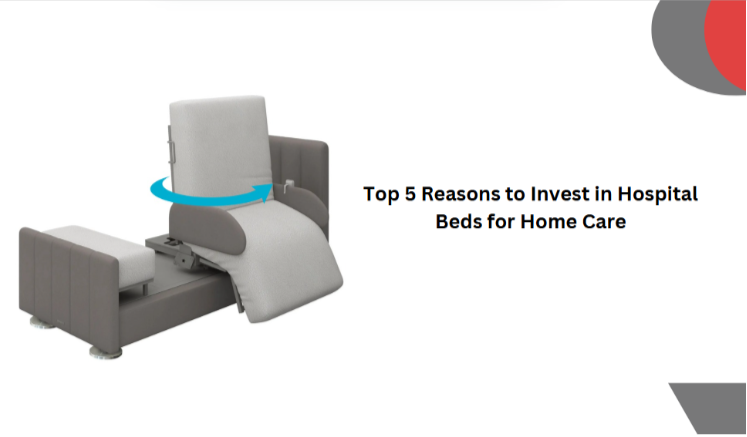Caring for a loved one at home who is recovering from surgery, dealing with chronic illness, or facing mobility challenges can be overwhelming without the right tools. One of the most essential investments in this journey is a hospital bed. While traditional beds may offer a familiar environment, they often lack the support and features needed to provide proper care.
If you’re on the fence about getting a hospital bed for home care, this post will walk you through the top five reasons why it’s a wise investment—for both the patient and the caregiver. Plus, we’ll touch on how pairing the bed with a specialized low air loss mattress can significantly improve comfort and health outcomes.
1. Enhanced Comfort and Support
Hospital beds are designed with patient comfort in mind. Whether your loved one needs to spend hours in bed each day or is completely bedridden, these beds offer adjustable positions that traditional home beds simply can’t match.
Patients can raise or lower the head and leg sections, helping them sit up comfortably, reduce pressure on joints, or improve circulation. This is especially helpful for those with back pain, respiratory issues, or difficulty getting in and out of bed.
Pairing a hospital bed with a low air loss mattress can take comfort to the next level. These mattresses offer continuous airflow that helps regulate skin temperature and reduce moisture buildup—key for preventing pressure ulcers.
2. Increased Safety for Patients and Caregivers
Home environments often aren’t equipped to handle the unique safety needs of someone with limited mobility. Standard beds are typically low to the ground and lack side rails, making it easier for a patient to fall or have difficulty getting out of bed.
Hospital beds come equipped with safety rails that reduce the risk of accidental falls—especially for elderly patients or those with cognitive impairments like dementia. Many models also include features like adjustable height and locking wheels, which add stability and safety during transfers.
For caregivers, this means less physical strain when helping patients move, adjust, or bathe. Raising the bed to a comfortable height can prevent injuries like back strain or sprains caused by awkward lifting.
3. Better Support for Medical Needs
Whether you’re dealing with short-term recovery or long-term illness, hospital beds make it easier to manage medical routines at home. Some of the ways they can support treatment include:
- Easier positioning for feeding tubes or IV lines
- Improved breathing with elevated head positions
- Smoother hygiene routines and sponge baths
- Support for physical therapy and repositioning exercises
Advanced hospital beds can even be customized with features like Trendelenburg and reverse Trendelenburg positions, commonly used in hospitals to treat certain circulatory or respiratory conditions.
For patients at high risk of developing bedsores or pressure ulcers, a low air loss mattress offers added medical benefit. It helps with skin protection, improves circulation, and relieves pressure points, all of which contribute to better healing and lower risk of complications.
4. Promotes Independence and Dignity
Maintaining dignity is crucial for patients—especially when they’re experiencing loss of mobility. One of the biggest psychological challenges of home care is the feeling of helplessness. Hospital beds can restore a sense of control by allowing patients to reposition themselves, sit up for meals, or adjust their bed without waiting for assistance.
With full-electric hospital beds, all adjustments can be made at the push of a button. This enables the patient to handle some of their needs independently, which not only boosts their morale but also eases the workload for caregivers.
Even a semi-electric bed can be a significant upgrade from a traditional bed, offering partial independence while keeping costs lower.
5. Long-Term Cost Savings and Peace of Mind
At first glance, hospital beds might seem expensive, but they’re an investment in health and convenience. When you factor in the cost of complications from falls, injuries, or pressure sores, the price of a hospital bed is well justified.
Here’s how investing in a hospital bed for home care saves money in the long run:
- Reduces need for frequent hospital visits
- Prevents caregiver injuries and related medical bills
- Extends the life of the mattress and bedding by offering better support
- Minimizes the chance of patient complications that require additional care
Moreover, having the right bed offers peace of mind. You know your loved one is resting in a space that’s safe, comfortable, and supportive of their health needs—without the sterile feeling of a hospital room.
Bonus Tip: Don’t Forget the Mattress
While choosing the right hospital bed is essential, the mattress is just as important—if not more so. A low air loss mattress is highly recommended for patients who will spend long hours in bed or are already at risk of skin issues.
These mattresses work by circulating air through a series of interconnected cells to reduce pressure on the skin and keep it dry. They help:
- Prevent bedsores
- Reduce pain from prolonged lying
- Regulate temperature and moisture
Using a hospital bed without a proper mattress can defeat its purpose, so always consider this as part of the complete setup.
Final Thoughts
Choosing to care for a loved one at home is a brave and compassionate decision. But it doesn’t mean you have to compromise on comfort, safety, or care quality. A hospital bed for home use is one of the best investments you can make to ensure your patient’s needs are met effectively.
With benefits ranging from medical support to emotional well-being, a hospital bed transforms the caregiving experience. And when paired with a low air loss mattress, it creates a supportive environment where healing and dignity go hand in hand.



